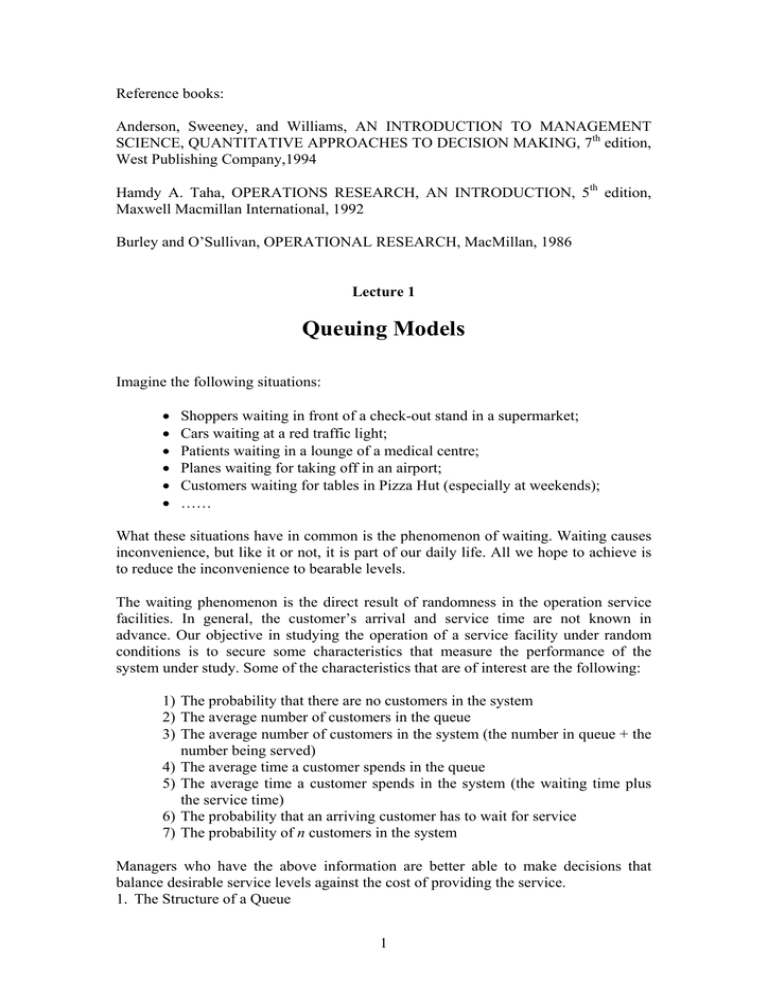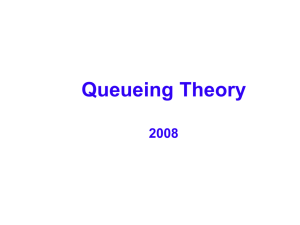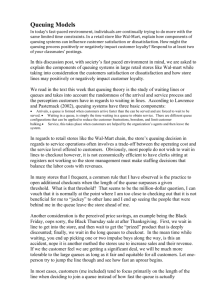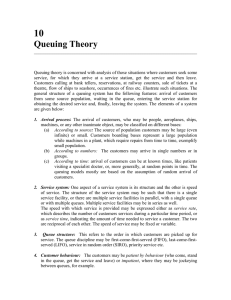Reference books: Anderson, Sweeney, and Williams, AN INTRODUCTION TO MANAGEMENT
advertisement

Reference books: Anderson, Sweeney, and Williams, AN INTRODUCTION TO MANAGEMENT SCIENCE, QUANTITATIVE APPROACHES TO DECISION MAKING, 7th edition, West Publishing Company,1994 Hamdy A. Taha, OPERATIONS RESEARCH, AN INTRODUCTION, 5th edition, Maxwell Macmillan International, 1992 Burley and O’Sullivan, OPERATIONAL RESEARCH, MacMillan, 1986 Lecture 1 Queuing Models Imagine the following situations: • • • • • • Shoppers waiting in front of a check-out stand in a supermarket; Cars waiting at a red traffic light; Patients waiting in a lounge of a medical centre; Planes waiting for taking off in an airport; Customers waiting for tables in Pizza Hut (especially at weekends); …… What these situations have in common is the phenomenon of waiting. Waiting causes inconvenience, but like it or not, it is part of our daily life. All we hope to achieve is to reduce the inconvenience to bearable levels. The waiting phenomenon is the direct result of randomness in the operation service facilities. In general, the customer’s arrival and service time are not known in advance. Our objective in studying the operation of a service facility under random conditions is to secure some characteristics that measure the performance of the system under study. Some of the characteristics that are of interest are the following: 1) The probability that there are no customers in the system 2) The average number of customers in the queue 3) The average number of customers in the system (the number in queue + the number being served) 4) The average time a customer spends in the queue 5) The average time a customer spends in the system (the waiting time plus the service time) 6) The probability that an arriving customer has to wait for service 7) The probability of n customers in the system Managers who have the above information are better able to make decisions that balance desirable service levels against the cost of providing the service. 1. The Structure of a Queue 1 As customers arrive at a facility, they join a queue. The server chooses a customer from the queue to begin service. Upon the completion of a service, the process of choosing a new waiting customer is repeated. This is how a queuing situation is created. It is assumed that no time is lost between the completion of a service and the admission of a new customer into the facility. A simple queuing system is illustrated in Figure 1. This diagram depicts a single channel queue, i.e., all customers entering the system must pass through the one channel. When more customers arrives at the facility, It is necessary the system have multiple channel queue to serve the customers. System Customer arrivals Queue Customer leaves Server Figure 1. A single channel queue system Obviously, the main “actors” in a queuing system are the customers and the server. The elements that are of most interest in the queuing system are the pattern in which the customers arrive, the service time per customer, and the queue discipline. The process of arrivals Defining the arrival process for a queue involves determining the probability distribution for the number of arrivals in a given period of time. In many queuing situations the arrivals occur in a random fashion; that is, each arrival is independent of other arrivals, and we cannot predict when an arrival will occur. In such cases, the Poisson probability distribution is used to describe the arrival pattern. Using Poisson probability function, the probability of x arrivals in a specific time period is defined as follows: P( x ) = λx e −λ x! (for x = 0, 1, 2…) where x = the number of arrivals in the period λ = the average or mean number of arrivals per period e = 2.71828 Example: 2 (1) The North-west Fried Chicken has analysed data on customer arrivals and has concluded that the mean arrival rate is 45 customers per hour. For a 1-minute period, the mean number of arrival would be λ = 45/60 = 0.75 arrivals per minute. We can use the following probability function to compute the probability of x arrivals during a 1-minute period: 0.75 x e −0.75 P( x ) = x! The Poisson probability distribution during a 1-minute period is listed as follows: x P(x) 0 1 2 3 4 ≥5 0.4724 0.3543 0.1329 0.0332 0.0062 0.0010 The distribution of service times The service time is the time the customer spends at the service facility once the service has started. Service time normally varies according to the individual situations. In the North-west Fried Chicken example, each customer’s order may be of different sizes. It may take 1 minute to fill a small order, but 2 or 3 minutes to fill a larger order. It has been determined that the exponential probability distribution often provides a good approximation of service times in queuing situations. If the probability distribution for service times follows an exponential probability distribution, the probability that the service time will be less than or equal to a time of length t is given by P(service time ≤ t) = 1 - e-μt where (2) μ = the average or mean number of customers that can be served per time period Example: Suppose that North-west Fried Chicken has studied the order-taking and order- filling process and has found that the single server can process an average of 60 customer orders per hour. On a 1-minute basis, the average or mean service rate would be μ = 60/60 = 1 customer per minute. This makes the equation (2) become 3 P(service time ≤ t) = 1 - e-t for this case. For example P(service time ≤ 0.5 min.) = 1 - e-1(0.5) = 1 - 0.6065 = 0.3935 P(service time ≤ 1.0 min.) = 1 - e-1(1.0) = 1 - 0.3679 = 0.6321 P(service time ≤ 2.0 min.) = 1 - e-1(2.0) = 1 - 0.1353 = 0.8647 Queue discipline In describing a queuing system, we must define the manner in which the queuing customers are arranged for service. The possible queue disciplines are 1) 2) 3) 4) First-in-first-out (FIFO) or first-come-first-served (FCFS) Last-in-first-served (LIFO) Service-in-random-order (SIRO) Others The FIFO or FCFS queue discipline applies to many situations. Steady-state operation A queuing system gradually builds up to a normal or steady state from its beginning. The start-up period is known as the transient period. This period ends when the system reaches the normal or steady-state operation. Queuing models describe the steady-state operating characteristics of the queue. Lecture 2 2. The Single-channel Queue Model with Poisson Arrivals and Exponential Service Times This is the simplest queuing model and it assumes the following: 1) 2) 3) 4) The queue has a single channel The pattern of arrivals follows a Poisson probability distribution The service times follow an exponential probability distribution The queue discipline is FCFS The formulas that can be used to develop the steady-state operating characteristics in this situation are given below, with 4 λ = the mean or average number of arrivals per time period (the mean arrival rate) μ = the mean or average number of services per time period (The mean service rate) • The probability that there are no customers in the system P0 = 1 - λ/μ (3) • The average number of customers in the queue Lq = λ2/[μ(μ-λ)] (4) • The average number of customers in the system (the number in queue + the number being served) L = Lq + λ/μ (5) • The average time a customer spends in the queue Wq = Lq/λ (6) • The average time a customer spends in the system (the waiting time plus the service time) W = Wq + 1/μ (7) • The probability that an arriving customer has to wait for service Pw = λ/μ (8) • The probability of n customers in the system Pn = (λ/μ)n P0 (9) Formula (8) provides the probability the service facility is busy, and thus the ratio λ/μ is often referred to as the utilisation factor for the service facility. The above formulas are applicable only when the mean service rate μ is greater than the mean arrival rate λ, i.e., when λ/μ < 1. If this condition does not exist, the queue will grow without limit since the service facility does not have sufficient ability to handle the arriving customers. Therefore, to use these formulas, we must have μ > λ. Example: Recall that for the North-west Fried Chicken problem we had a mean arrival rate of λ = 0.75 customers per minute and a mean service rate of μ = 1 5 customers per minute. Obviously the condition λ/μ < 1 is satisfied. Then we can use the formulae to calculate the operation characteristics for North-west Fried Chicken single queue: P0 = 1 - λ/μ = 1 - 0.75/1 = 0.25 Lq = λ2/[μ(μ-λ)] = 0.752/[(1(1-0.75)] = 2.25 customers L = Lq + λ/μ = 2.25 + 0.75/1 = 3 customers Wq = Lq/λ = 2.25/0.75 = 3 minutes W = Wq + 1/μ = 3 + 1/1 = 4 minutes Pw = λ/μ = 0.75/1 = 0.75 Equation Pn = (λ/μ)n P0 can be used to determine the probability of any number of customers in the system. Some computation results are listed in the following table. Numbers of Customers Probability 0 1 2 3 4 5 6 ≥7 0.2500 0.1875 0.1406 0.1055 0.0791 0.0593 0.0445 0.1335 Looking at the results of the single-channel queue for the North-west Fried Chicken, we can learn several important things about the operation of the queuing system: • Customers wait an average of 3 minutes before beginning to place an order, which is somewhat long for a business based on fast service; • the average number of customers waiting in line is 2.25 and 75% of the arriving customers have to wait for service; this indicates something needs to be done to improve the efficiency of the queue operation; • There is a 0.1335 probability that seven or more customers are in the queuing system at one time, which indicates a fairly high probability that the North-west Fried Chicken will periodically experience some very long queues if it continues to use the single channel operation. If the operating characteristics are unsatisfactory in terms of meeting companies standards for service, something will need to be done to improve the queue operation. To reduce the waiting time mainly means to improve the services rate. The service improvements can be made by either 6 • increasing the mean service rate μ by making a creative change or by employing new technology; or • adding parallel service channels so that more customers can be served at a time. Example: Suppose that the North-west Fried Chicken management decides to increase the mean service rate μ by employing an order filler who will assist the order taker at the cash machine. By this change, the management estimates that the mean service rate can be increased from the current 60 customers/hour to 75 customers/hour. The mean service rate for the revised system is μ = 75/60 = 1.25 customers per minute. Then using λ = 0.75 and μ = 1.25, the characteristics of the revised system are calculated as follows: Operating Characteristics Probability of no customers in the system Average number of customers in the queue Average number of customers in the system Average time a customer spends in the queue Average time a customer spends in the system Probability of an arriving customer has to wait for service Probability of 7 or more customers in the system Original 0.2500 2.2500 3.000 3.000 min. 4.000 min. 0.75 0.1335 Revised 0.400 0.900 1.500 1.200 min. 2.000 min. 0.600 0.028 Comparison between the original system and the revised system shows the service of the North-west Fried Chicken has been greatly improved due to the action taken. Lecture 3 3. The Multiple-channel Queuing Model with Poisson Arrivals and Exponential Service times A multiple-channel queue consists of two or more channels or service locations that are assumed to be identical in terms of service capability. In the multiple channel system, arriving customers wait in a single queue and then move to the first available channel to be served (such as the queue waiting to pass the security check in Manchester airport). A 3-channel queuing system is depicted in Figure 2. 7 System Server1 Customer leaves Customer arrivals Server2 Customer leaves Server3 Customer leaves Queue Figure 2. A three channel queue system Assumptions for the queue in the multiple-channel system: • The queue has two or more channels • The pattern of arrivals follows a Poisson probability distribution • The service time for each channel follows an exponential probability distribution • The mean service time μ is the same for each channel • The arrivals wait in the single queue and then move to the first open channel for service • The queue discipline is first-come, first-served (FCFS) Notations: λ = the mean arrival rate for the system μ = the mean service rate for each channel k = the number of the channels Formulas: 1) The probability that there are no customers in the system P0 = 1 k ⎛ ⎞ ∑ ( λ /nμ! ) + ( λ /kμ! ) ⎜⎝ kμkμ− λ ⎟⎠ n= 0 k −1 n 2) The average number of customers in the queue 8 (10) ( λ / μ ) k λμ Lq = P ( k − 1)!( kμ − λ ) 2 0 (11) 3) The average number of customers in the system L = Lq + λ/μ (12) 4) The average time a customer spends in the queue Wq = Lq/λ (13) 5) The average time a customer spends in the system W = Wq + 1/μ (14) 6) The probability that an arriving customer has to wait for service 1 ⎛λ⎞ Pw = ⎜ ⎟ k !⎝ μ ⎠ k ⎛ kμ ⎞ ⎜ ⎟P ⎝ kμ − λ ⎠ 0 (15) 7) The probability of n customers in the system Pn = ( λ / μ )n P0 n! for n ≤ k (16) Pn = ( λ / μ )n P k ! k ( n−k ) 0 for n > k (17) While some of the formulas for the operating characteristics of multiple-channel queues are more complex than their single-channel counterparts, the expressions provide the same information. The following table is provided to simplify the use of the formulas. Values of P0 for multiple-channel queue with Poisson arrivals and exponential service time Ratio λ/μ 0.15 0.20 0.25 0.30 0.35 0.40 0.45 0.50 0.55 0.60 0.65 0.70 0.75 0.80 0.85 k=2 0.8605 0.8182 0.7778 0.7391 0.7021 0.6667 0.6327 0.6000 0.5686 0.5385 0.5094 0.4815 0.4545 0.4286 0.4035 k=3 0.8607 0.8187 0.7788 0.7407 0.7046 0.6701 0.6373 0.6061 0.5763 0.5479 0.5209 0.4952 0.4706 0.4472 0.4248 k=4 0.8607 0.8187 0.7788 0.7408 0.7047 0.6703 0.6376 0.6065 0.5769 0.5487 0.5219 0.4965 0.4722 0.4491 0.4271 9 k=5 0.8607 0.8187 0.7788 0.7408 0.7047 0.6703 0.6376 0.6065 0.5769 0.5488 0.5220 0.4966 0.4724 0.4493 0.4274 0.90 0.95 1.00 1.20 1.40 1.60 1.80 2.00 2.20 2.40 2.60 2.80 3.00 3.20 3.40 3.60 3.80 4.00 4.20 4.40 4.60 4.80 0.3793 0.3559 0.3333 0.2500 0.1765 0.1111 0.0526 0.4035 0.3831 0.3636 0.2941 0.2360 0.1872 0.1460 0.1111 0.0815 0.0562 0.0345 0.0160 0.4062 0.3963 0.3673 0.3002 0.2449 0.1993 0.1616 0.1304 0.1046 0.0831 0.0651 0.0521 0.0377 0.0273 0.0186 0.0113 0.0051 0.4065 0.3867 0.3678 0.3011 0.2463 0.2014 0.1646 0.1343 0.1094 0.0889 0.0721 0.0581 0.0466 0.0372 0.0293 0.0228 0.0174 0.0130 0.0093 0.0063 0.0038 0.0017 Example: Consider the North-west Fried Chicken situation again. If the management decided to add a parallel service channel to improve the service rather than to increase the mean service rate μ, let’s evaluate the operating characteristics for the two-channel system. We know that k = 2, λ = 0.75, and μ = 1. So, P0 = 0.4545 (from table) Lq = 0.1227 customer L = 0.8727 customer Wq = 0.16 min. W = 1.16 min. Pw = 0.2045 Pn≥7 = 0.0017 Operating Characteristics Probability of no customers in the system Average number of customers in the queue Average number of customers in the system Average time a customer spends in the queue Average time a customer spends in the system Probability of an arriving customer has to wait for service Probability of 7 or more customers in the system Original 0.2500 2.2500 3.000 3.000 min. 4.000 min. 0.75 0.1335 Revised 1 0.400 0.900 1.500 1.200 min. 2.000 min. 0.600 0.028 Revised 2 0.4545 0.1227 0.8727 0.16 min. 1.16 min. 0.2045 0.0017 It is clear that the two-channel system will greatly improve the operating characteristics of the queue. Lecture 4 10 4. Some General Relationships for Queuing Models In sections 2 and 3, we have come across a number of operating characteristics including Lq = the average number of customers in the queue L = The average number of customers in the system Wq = the average time a customer spends the queue W = the average time a customer spends in the system John D. C. Little showed that general relationships existing among these four characteristics apply to a variety of different queues. Two of the relationships, referred to as Little’s flow equation, are as follows: L = λW Lq = λWq (18) (19) Another general relationship is the expression for the average time in the system: W = Wq + 1/μ The importance of these relations is that they apply to any queuing models regardless the arrival patterns and the service time probability distribution. 5. Economic Analysis of Queues For a queuing system, the manager has to decide at what level the system should be run so that it is most economical. In other word, the manager has to make sure that the total cost for operating the queuing system is minimised. In queuing systems, the total cost comes from two directions, i.e. the waiting cost and the service cost. Let’s use the following notations: cw = the waiting cost per time period for each customer L = the average number of customers in the system per time period cs = the service cost per time period for each channel k = the number of channels TC = the total cost Then the total cost is TC = cwL + csk (20) A critical issue in conducting an economic analysis of a queue is to obtain reasonable estimates of the waiting cost and service cost per period. Of these two, the waiting cost per period is usually more difficult to evaluate. This is not a direct cost to a company. However, if this cost is ignored and the queue is allowed to grow, customers will ultimately take their business to elsewhere. In this way, the company 11 will experience lost sales, and incur a cost. The service cost is generally easier to determine. This cost is the relevant cost associated with operating each service channel. Example: Assume that in the case of Northwest Fried Chicken, the waiting cost rate is £10 per hour for customer waiting time and the service cost rate is £7 per hour. Calculate the total cost for single-channel and two-channel queuing system: Single-channel system: We knew that the average number of customers in the system L = 3. So TC = £10 (3) + £7 (1) = £37.00 per hour Two-channel system: L = 0.8727 TC = £10 (0.8727) + £7 (2) = £22.73 per hour Thus, given the cost data provided by the North-west Fried Chicken, the two-channel system provides the more economical operation. The general shapes of the cost curves in the economic analysis of queues are show in Figure 3. Total Cost per Hour Total cost Service cost Waiting cost Figure 3 Number of Channels (k) 12 4. Other queuing Models D G Kendall suggested a notation that is helpful in classifying the wide variety of different queuing models that have been developed. The three-symbol notation Kendall notation is as follows: A/B/s where A denotes the probability distribution for the number of arrivals B denotes the probability distribution for the service time s denotes the number of channels The values for A and B that are commonly used are as follows: M designates a Poisson probability distribution for the number of arrivals or an exponential probability distribution for service time D designates that the number of arrivals or service time is deterministic or constant G designates a general distribution with a known mean and variance for the number of arrivals or service time Using the Kendall notation, the single-channel queuing model with Poisson arrivals and exponential service times is classified as an M/M/1 model. The two-channel queuing model with Poisson arrivals and exponential service times would be classified as an M/M/2 model. We will not cover the other queuing models because of time limitation and the similarity of the equations for the operating characteristics. These equations can be found in the listed reference books. 13 Exercise 3 Queuing Models 1. The reference desk of a university library receives requests for assistance. Assume that a Poisson probability distribution with a mean rate of 10 requests per hour can be used to describe the arrival pattern and that service times follow the exponential probability distribution with a mean service rate of 12 request per hour. a. b. c. d. What is the probability that there are no requests for assistance in the system? What is the average number of requests that will be waiting for service? What is the average waiting time in minutes before the service begins? What is the average time at the reference desk in minutes (waiting time + service time)? e. What is the probability that a new arrival has to wait for service? 2. Trucks using a single-channel loading dock arrive according to Poisson probability distribution. The time required to load/unload follows the exponential probability distribution. The mean arrival rate is 12 trucks per day, and the mean service rate is 18 trucks per day. a. b. c. d. What is the probability that there are no trucks in the system? What is the average number of trucks waiting for service? What is the average time a truck waits for loading/unloading service to begin? What is the probability that a new arrival will have to wait? 3. Marty’s Barber Shop has one barber. Customers arrive at the rate of 2.2 customers per hour, and haircuts are given at the average rate of 5 per hour. Use the Poisson arrivals and exponential service times model to answer the following questions: a. What is the probability that there are no customers in the system? b. What is the probability that 1 customer is receiving a haircut and no one is waiting? c. What is the probability that 1 customer is receiving a haircut and 1 customer is waiting? d. What is the probability that 1 customer is receiving a haircut and 2 customers are waiting? e. What is the probability that more than two customers are waiting? f. What is the average time a customer waits for service? 4. Trosper Tire Company has decided to hire a new mechanic to handle all tire changes for customers ordering a new set of tires. Two mechanics have applied for the job. One mechanic has limited experience and can be hired for $14 per hour. It is expected that this mechanic can serve an average of 3 customers per hour. The other mechanic has several years of experience. This mechanic can service a average of 4 customers per hour, but must be paid $20 per hour. Assume the customers arrive at the Trosper garage at the rate of 2 customers per hour. 14 a. Compute the waiting line characteristics for each mechanic, assuming Poisson arrivals and exponential service times. b. If the company assigns a customer waiting cost of $30 per hour, which mechanic provides the lowest operating cost? 5. Consider a two-channel waiting line with Poisson arrivals and exponential service times. The mean arrival rate 14 units per hour, and the mean service rate is 10 units per hour for each channel. a. b. c. d. e. What is the probability that there are no units in the system? What is the average number of units in the system? What is the average time a unit waits for service? What is the average time a unit is in the system? What is the probability of having to wait for service? 6. Refer to Problem 5. Assume that the system is expanded to a three-channel operation. a. Compute the operating characteristics for this waiting line system. b. If the service goal is to provide sufficient capacity so that at most 25% of the customers have to wait for service, is the two- or three-channel system preferred? 7. Patients arrive at a dentist’s office at a mean rate of 2.8 patients per hour. The dentist can service patients at the mean rate of 3 patient per hour. A study of patient waiting times shows that, on average, a patient waits 30 minutes before seeing the dentist. a. What are the mean arrival rate and mean service rate in terms of patients per minute? b. What is the average number of patients in the waiting room? c. If a patient arrives at 10:19 am. What is the expected time the patient will leave the office? 8. The City Beverage Drive-Thru is constructing a two channel service system. Cars arrive according to the Poisson probability distribution, with a mean arrival rate of 6 cars per hour. The service times have an exponential probability distribution, with a mean service rate of 10 cars per hour for each channel. a. b. c. d. e. What is the probability that there are no cars in the system? What is the average number of cars waiting for service? What is the average time waiting for service? What is the average time in the system? What is the probability that an arrival will have to wait for service? 15






